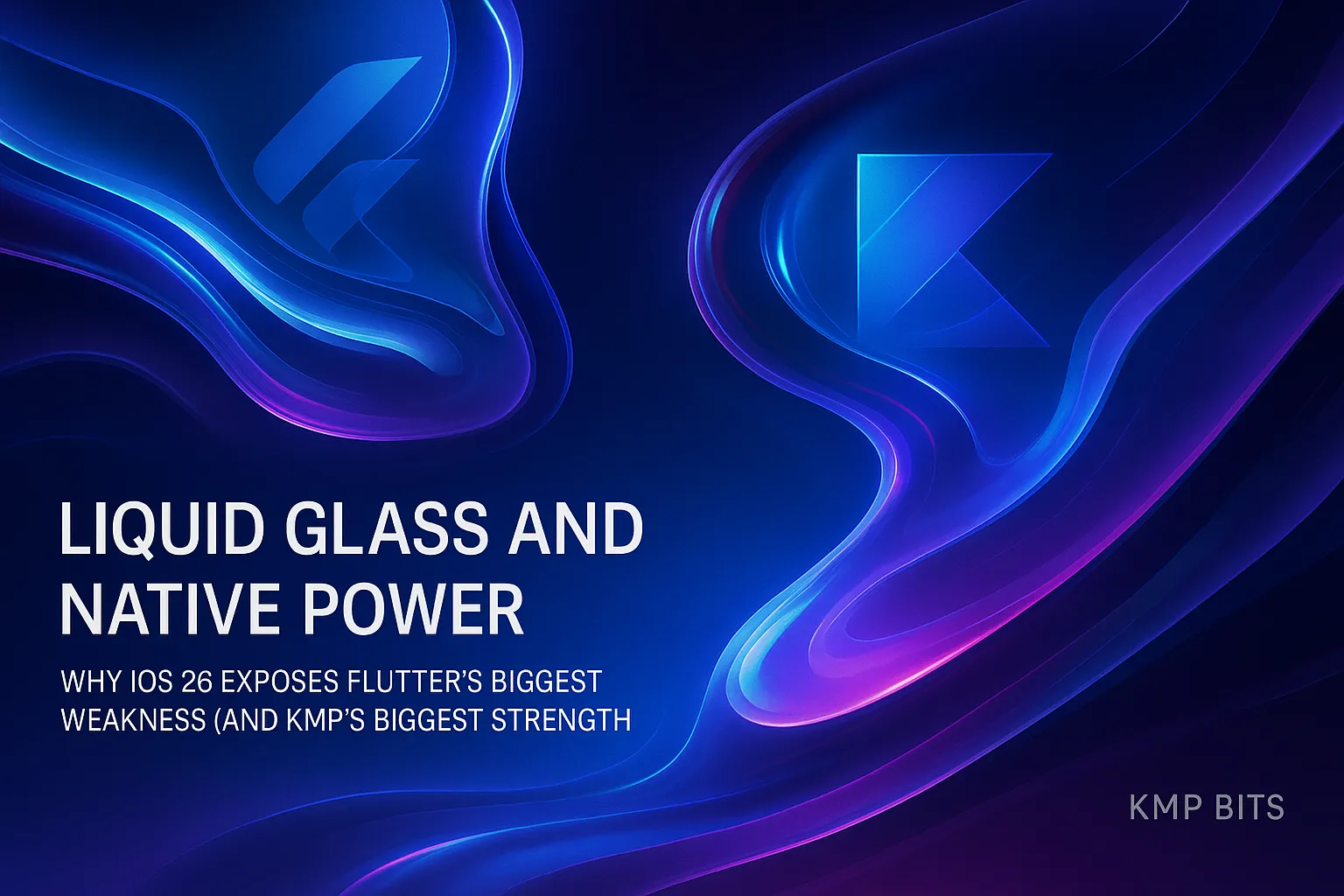
Originally published on Medium
Imagine you’re driving a slick sports car on a high-tech racetrack. Suddenly, the track gets a futuristic upgrade — glass so smooth and responsive; it feels like you’re floating on liquid silk.
Now imagine your car can’t actually feel the difference because it’s stuck using old tires.
That’s basically what just happened with Apple’s iOS 26 and its new UI effect called Liquid Glass — a stunning leap in visual design that only native apps truly get to experience. While native-first frameworks get this magic baked in automatically, Flutter, known for its “write once, run everywhere” mantra, finds itself on the sidelines.
But here’s the twist: Kotlin Multiplatform (KMP) quietly zips by, using native UI where it matters most and reaping the benefits of Apple’s latest trick without breaking a sweat.
And if you’re wondering what this all means in real code, I’ve been putting together demos in both KMP with SwiftUI and Compose Multiplatform, so you can see the difference in action.
🧊 So, What Exactly Is Liquid Glass?
Apple just dropped iOS 26 and brought along Liquid Glass, basically, the lovechild of Frosted Glass and pure futuristic energy. It’s smooth, reactive, and honestly kind of mesmerizing. Buttons ripple, panels shift light like living glass; it’s Apple’s biggest UI glow-up in years.
And the best part? It’s not a new rendering engine. It’s built right into UIKit and SwiftUI, which means native apps get it for free. No extra work. No hacks. Just pure, shimmering elegance — out of the box.
🤔 Why This Is a Problem for Flutter
Here’s the deal: Flutter doesn’t use native UI components. It renders everything via Skia, its own graphics engine. That’s great for visual consistency across platforms — but not so great when Apple drops some next-level sauce that lives inside UIKit or SwiftUI.
Liquid Glass is baked into the native frameworks. Flutter can’t just flip a switch and get the effect. Supporting it would mean rearchitecting part of their rendering engine — not exactly a weekend fix.
So while native apps and KMP-powered iOS apps are already cruising through Liquid Glass like pros, Flutter is left trying to simulate the experience — with way more effort and, honestly, less fidelity.
🚀 Why Kotlin Multiplatform Wins Here
Flutter is the one-car-for-every-track kind of framework. KMP? It’s the kind of driver that switches cars depending on the race.
Kotlin Multiplatform takes a different approach: share what makes sense (like business logic and networking), but keep the UI native. On iOS, you write SwiftUI or UIKit. On Android, you use Jetpack Compose or Views. It’s native-first, platform-true development with shared brains.
That means when Apple brings Liquid Glass to town, you just… get it. No delay. No hacks. No waiting on framework updates.
KMP lets you reuse code where it counts and embrace platform evolution where it matters. Win-win.
⚖️ The Real Trade-Off: Control vs. Consistency
Flutter is still fantastic. Its consistent UI across platforms is one of the best in the game. But that consistency comes from rendering everything itself — and that means it’s always one step behind when Apple or Google changes the rules of the track.
KMP is okay with letting the UI be different — because that’s what users expect. And when the platform evolves, you’re already in the driver’s seat.
So the question becomes: Do you want pixel-perfect parity or native innovation?
Because Liquid Glass proves that those two goals might not always align.
🎯 Final Thoughts
Flutter isn’t dying. Let’s be clear, it’s still a powerhouse with amazing tooling and a strong ecosystem. But iOS 26’s Liquid Glass is a turning point. It shows that choosing a native UI might not just be about aesthetics, it could be about future-proofing your entire app.
Kotlin Multiplatform isn’t here to replace Flutter, it’s offering another path: one that shares code smartly, respects platform differences, and takes full advantage of the latest native innovations.
And honestly? With SwiftUI on one side and Compose on the other, it’s never been easier, or funnier, to go native in both worlds.
👨💻 Wanna See This in Action?
I’ve been building some demos that show Kotlin Multiplatform working beautifully with both SwiftUI and Compose Multiplatform — including full state-sharing, native effects, and yes, the kind of visual magic you’d expect from something like Liquid Glass.
👉 Check out the code, experiments, and more on KMP Bits
If you’re curious about KMP, want to try the native route, or just wanna geek out over shiny new UI tech — you’re in the right place.
Let’s build cool stuff. 🚀